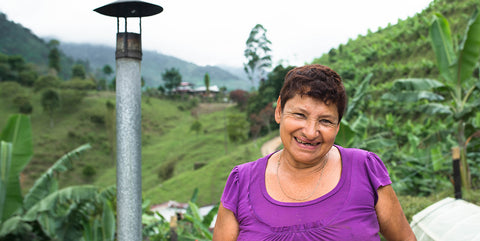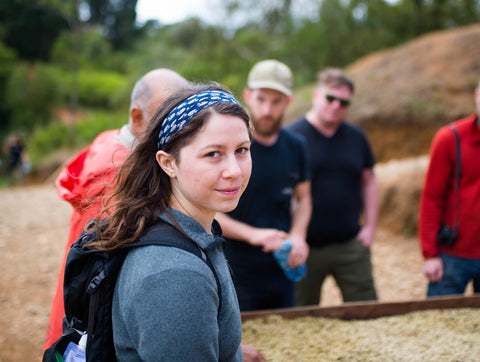Driving from the airport in Managua to the northern town of Matagalpa felt like a homecoming. I spent a whole day in Managua with my travel companions Shannon and Leah. Shannon is close friends with the Blanchard’s and lived in Nicaragua ten years ago working at the Casa Bernabe orphanage in Managua, and we spent our first day visiting her old colleagues and friends, but it wasn’t until we were cruising down the Pan-American Highway heading north into the lush green mountains that I truly felt like I was going where I belonged. Every turn in the road felt familiar. Even the smells of diesel fuel and wood fires burning combined with the earthiness from the sprawling pastures of grazing cattle felt like something I knew.

My first visit to Nicaragua in January was hard. I had never traveled to a third world country and I wasn’t prepared for what I would see. It was difficult, emotionally, as I was constantly confronted with my own feelings of guilt for living my “American lifestyle”, and felt tremendous grief and sadness for the people I met living in conditions of poverty and a lack of the comforts we so often take for granted. I wanted to give everything I had to them. It seemed as if each child was in need of basic necessities like new shoes, clothes, basic medical and dental care, and mothers and fathers struggled to provide consistent nutritious food and vitamins to their families. I was overwhelmed by the feeling that everyone I met was in need, and I didn’t know how or what to give that would be the most effective in helping these families; families who, despite their hardships, were content, hard-working, happy, and proud of their homes and families. Part of the reason I wanted to come back to Nicaragua was to be able to do something to help these families who touched me so deeply during my first visit.

and support of our customers. Seeing the progress of those construction projects was important to us from an accountability standpoint. Construction of the new schoolhouse was mostly complete when we arrived, while the kitchen was still in the early stages of construction. Besides the obvious reason of giving children a place to learn, the schoolhouse gives the workers and families at San Jose a place to be together as a community - something that they were missing before. When we arrived at the farm we met all the children and their teacher in the schoolhouse, each child sitting patiently at their desk. The school is built into the side of a hill, overlooking coffee trees and rainforests in the distance, with hand milled custom wood beams forming the eves, and thick grey concrete blocks forming the shape of the building. One of our projects while visiting was to paint a mural inside the school using the blue and white stripes of the Nicaraguan flag as the background. We traced the handprints of each child onto the wall and then asked them to color it in with bright colors and finish it with their name printed underneath. The classroom was already decorated with a few craft projects that children had made with their teachers, like colorful fish cut out of cardboard, signs that read “Aqui aprendemos con amor (here we learn with love),” a poster board with “Reglamento Escolar (School Rules),” and a plaque that had the national symbols of Nicaragua, the flower Sacuanjoche, the Madroño tree, and a bird called the Guardabarranco.

The school gives us a unique opportunity to shape the development of the children on the farm and watch them as they grow. The educational system in Nicaragua is deeply complex and shaped by the country’s long history of war and dictatorships. Most teachers in Nicaragua are not equipped with the resources needed to address increasing gaps in development and learning, or to relate curriculum to the lives of the children they are teaching. As a result, children often end up with a lot of information but little knowledge of methods for organizing and transforming that information into knowledge that can be applied to the realities of their daily life. We had a sense of that when we were attempting to do crafts with the children and they couldn’t tell us what animal they wanted to make out of construction paper without being prompted with a suggestion. I’m hoping that the more time we are able to spend doing activities with the children, the more comfortable they will be expressing their creativity and individual personalities.

A big problem that plays into low school attendance is poverty. There are very strict government guidelines for what each child needs to attend school — a uniform, books, stationary supplies — but many children’s families, including those at Finca San Jose, cannot afford those necessities and therefore the children are excluded from attending school. To address this, Blanchard’s and supporters committed to providing school supplies for 73 children in the immediate surrounding areas of San Jose. While education is free and compulsory for elementary school, only about 30% of all children enrolled will make it past the sixth grade. After understanding how unique the education system is in Nicaragua, Blanchard’s has embraced every effort suggested to enhance the children’s learning opportunities. Employees of Blanchard’s donated money to our trip and with that money we were able to buy uniforms for the seven children on the farm who attend school every day. The uniforms consisted of new shoes, socks, pleated navy pants, and a crisp white button up shirt. Giving out the uniforms to the children was a special feeling, especially seeing some of the children get so excited to replace their old muddy and tattered shoes with brand new mary-janes for the girls or dress shoes for the boys.

We again visited the clinic that inspired my desire to give back during our visit in January. The clinic, La Esmeralda is on the same road leading to the coffee farm. The clinic serves around 10,000 people per year from the community and functions mostly in thanks to donors in the United States. There we brought over 200 bottles of prenatal vitamins for the clinic to be distributed to pregnant women in the community. The cost of a bottle of prenatal vitamins can cost, on average, $80 in Nicaragua compared to $15 in the United States. Nicaragua has the second highest percentage of adolescent pregnancies of Latin America. Limited practice of contraception and early sexual initiation contributes to that statistic, along with the long months that agricultural workers spend away from home. As a result, there is a high prevalence of single mothers, infant and maternal mortality, and undernourished infants. While we were visiting the clinic we saw a young girl breastfeeding her baby, we were told that she is only fourteen and the father is twelve. We had been told many times about the large number of adolescent pregnancies within the community, but the first time seeing a mother so young caring for her baby was still jarring.

Dental hygiene in the rural mountain community of La Esmeralda is also severely lacking. In rural Nicaragua where poverty levels are high, most people don’t have access to dental care. Hygiene supplies like toothbrushes and toothpaste are not as readily available or affordable for these rural communities. We came prepared to start implementing preventative dental care with the children through the application of fluoride for kids up to age eighteen. Our friends with Love Nicaragua (a nonprofit that works in Nicaragua to provide medical attention to the community of Rancho Grande) graciously donated fifty fluoride treatment applications. Applying such a small noninvasive treatment such as fluoride is something simple that a few non-medically certified members of our group were able to do with little training beforehand. Darleta, of Love Nicaragua told us prior to our trip that she has seen extraordinary results from yearly fluoride treatments in a group of children she has been visiting in Rancho Grande over the last thirteen years. Our hope is that with the continued practice of fluoride applications every six months to a year when we visit, we will see noticeable and measurable results in decreased tooth decay and improved dental health overall.
Perhaps more than any other part of the trip, I was looking forward to finally seeing Mayela, the farm manager at San Jose, again after talking to her every day for six months and planning the details of our return for just as long. The amount of work that she put into preparing for our visit was clear. She made name tags for us and all of the people on the farm along with a welcome banner for Blanchard’s placed across the schoolhouse wall. She helped get word out in the community that we were coming to the clinic and the farm to give fluoride treatments and vitamins. Moving forward, I plan to work with Mayela to learn about her dreams for the future of Finca San Jose and her own personal aspirations. She and I have both grown more confident in our roles as women in coffee production. She walks with confidence and smiles more than when I first met her. Some of that can be attributed to the fact that we are more comfortable with each other now that we talk more often. Even with my poor Spanish skills, we were able to laugh, and work together towards giving a better life to people in her community.

Words by Tamara South
Photos by Cason Ulmer




